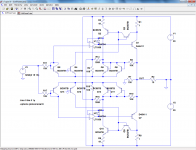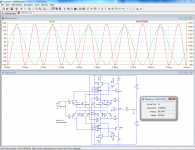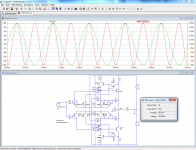Here the link for Stanley White website:
Stan White tube amplifiers and ShotGlass speakers
Francesco
Stan White tube amplifiers and ShotGlass speakers
Francesco
I posted this because I find the concept and its implementation fascinating, the same fascination D. Self has for similarly doomed and flawed concepts like this one:So I understand that you have posted the schematic not because you shared this idea but only for curiosity and pheraps to humiliate the author.
I'm sorry you feel that way.
Compressed-Air Locomotives
It shouldn't be too difficult, it is a relatively simple problem of analogue computingSince the relationship between the power from one side and the voltage, the current and the impedance of the other side are non-linear but quadratic relationship, then the big problem is to find a simple and fast circuit (no IC) which does not introduce distortions (no diodes) that implements such a function.
.Now coming back to the idea of Tai Nguyen-Tan, I think it was good
Not sure about that...
I ddon't think it has ever been actually implemented:interesting vintage approach.
here the pdf-paper:
PAT2PDF - Free PDF copies of patents: Download and print!
Do you know, in which commercial amplifier brand/model this topology is in use?
Maybe a small manufactur in France like YBA, Cairn-EZO or Lavardin
a/ It doesn't deliver the goods (output power is not constant)
b/ Setting the finality aside, it performs very poorly as an amplifier, and would be a nightmare to mass-produce because of the stability issues
I have also changed the 1K resistors to 100R@ Elvee
Hi, i noticed you had seen the BC337 NPN mistakes in the circuit & corrected them in your Pspice sim to BC557 PNP's
Was there anything else you corrected ?
Excellent work! This doesn't change it into a winner, but at least it has been rescued from abysmal depths....
Hi Elvee
now I marked that good results after substituting with modern parts were because idle through 1302/3128 was 600mA...
One is sure: when this amp is working in class B - this is disaster

Originally Posted by Elvee
I have also changed the 1K resistors to 100R
OK, Thanks
I posted this because I find the concept and its implementation fascinating, the same fascination D. Self has for similarly doomed and flawed concepts like this one:
Compressed-Air Locomotives
I find more and more sarcasm in your speeches. Glad you ...
It is well known by all that, looking back over time, it is easy to criticize the ideas of others
It shouldn't be too difficult, it is a relatively simple problem of analogue computing
Without IC?
Well, please explain it.
OK, here is a quick-and-dirty proof of concept.Without IC?
Well, please explain it.
It uses an opamp, but making a purpose-built discrete amplifier having better performances than a general purpose opamp for that specific use is not difficult: just tedious.
The important part, the mathematical "engine" is discrete.
This circuit is neither particularly accurate, as it uses many shortcuts and simplifications like V-I conversion with simple resistors, nor very clever because it is the direct translation of the mathematical function into circuit, but at least it actually does its job in a deterministic way.
A real circuit could be simplified and improved in many ways, here for example, the principal function resistors are 1Ω-100Ω-1K-10K, which doesn't give too much headache, but is certainly not optimal.
Attachments
This is another proof of how easy it is to see the speck in the eyes of others and not the trunk in his eyes!! 
Although I had already made clear the two necessary conditions in a previous post, thou hast rejected both!!
Your circuit is full of diodes of all types and of integrated circuits. Diodes in the signal path in both forward and feedback.
I think it is difficult to conceive a machine made for music more worst than this: a real crap technique (let me say) and it is not difficult to imagine that the Tai's circuit (which you have denigrated) is a lot more musical than yours.
Ultimately I think that your circuit is not designed to deal with a music signal.

Although I had already made clear the two necessary conditions in a previous post, thou hast rejected both!!

Your circuit is full of diodes of all types and of integrated circuits. Diodes in the signal path in both forward and feedback.
I think it is difficult to conceive a machine made for music more worst than this: a real crap technique (let me say) and it is not difficult to imagine that the Tai's circuit (which you have denigrated) is a lot more musical than yours.
Ultimately I think that your circuit is not designed to deal with a music signal.
Of course not. I thought that was clear from the beginning:Ultimately I think that your circuit is not designed to deal with a music signal.
This class of circuits, even properly implemented should have nothing to do with audio signals, and be confined to industrial processing and signal conditioning.
Anyway, by these standards my circuit is undoubtedly bad (I have no intention of building such a thing), but Tan Tai's is even seriously worse, quite visibly: it doesn't even do what it is supposed to good or bad, it simply harms the signal it processes.
You could also show your own version, so that we could assess how you succeeded in solving the "problems" you yourself highlighted.
Elvee you threw the stone in the pond and now hide your hand? You pulled out the Tai circuit you've criticized heavily, comparing it to a funny steam engine that would have never worked well...........
You have bragged to easily find a better solution, but your attempt has failed miserably, as for your implied admission..............
Then, later on to my criticisms, you have taken refuge in saying that your schema was not designed for audio applications..........
But then we what are we talking about? Haven't you noticed to be on an audio forum?.......
Yet, you are one of the more regular forum visitors..........
Yet it appears that right now on another thread someone should advice to build an audio amplifier designed by you ........http://www.diyaudio.com/forums/solid-state/209907-building-elvees-circlophone-documentation-parts-accessories-beginner-friendly.html
You've bragged to easily improve the Tai scheme and you have proposed a more worse ... ... ... ...
You said that you could easily design another circuit that created the sought mathematical function ... ... ... ...
But then, after my reply, admit that your circuit is good only to control a tool or process machine .
But, then again, what we are discussing? of music or of equipment?
When you design a circuit think about what to serve?
I was harsh in the reviews not because I do not esteem you, rather the opposite, but for exhort you to be more humble and moderate, moderate and respectful to both work and intellectual effort of others, especially of those of the past for obvious reasons that you can imagine.
Best regards
Francesco
You have bragged to easily find a better solution, but your attempt has failed miserably, as for your implied admission..............
Then, later on to my criticisms, you have taken refuge in saying that your schema was not designed for audio applications..........
But then we what are we talking about? Haven't you noticed to be on an audio forum?.......
Yet, you are one of the more regular forum visitors..........

Yet it appears that right now on another thread someone should advice to build an audio amplifier designed by you ........http://www.diyaudio.com/forums/solid-state/209907-building-elvees-circlophone-documentation-parts-accessories-beginner-friendly.html
You've bragged to easily improve the Tai scheme and you have proposed a more worse ... ... ... ...
You said that you could easily design another circuit that created the sought mathematical function ... ... ... ...
But then, after my reply, admit that your circuit is good only to control a tool or process machine .
But, then again, what we are discussing? of music or of equipment?
When you design a circuit think about what to serve?
I was harsh in the reviews not because I do not esteem you, rather the opposite, but for exhort you to be more humble and moderate, moderate and respectful to both work and intellectual effort of others, especially of those of the past for obvious reasons that you can imagine.
Best regards
Francesco
Thus, you imply that Tai's circuit does:Elvee you threw the stone in the pond and now hide your hand? You pulled out the Tai circuit you've criticized heavily, comparing it to a funny steam engine that would have never worked well...........
a/ what it is intended to do, ie provide constant power to a load
b/ provide a high enough quality for audio applications
c/ hence it is the present gold standard for such an application
I said that this class of circuits has nothing to do with audio applications. That include my circuit, and any future one, even one performing that function in an ideal manner. It could find an application in an effect box for guitar or something of the like, but that's all.You have bragged to easily find a better solution, but your attempt has failed miserably, as for your implied admission..............
Then, later on to my criticisms, you have taken refuge in saying that your schema was not designed for audio applications..........
Anyway, my solution is demonstrably better: it is stable, predictable, introduces moderate amounts of distortion, and most importantly it does its job
The original circuit was intended for audioBut then we what are we talking about? Haven't you noticed to be on an audio forum?.......
OK, be specific: in what matter exactly is it much worse?You've bragged to easily improve the Tai scheme and you have proposed a more worse ... ... ... ...
I think other members will have formed their opinion about this affirmation...
Yes to both: the circuit does perform the mathematical function, but applying messy non-linear functions to signals is more suited to control than for audio applicationsYou said that you could easily design another circuit that created the sought mathematical function ... ... ... ...
But then, after my reply, admit that your circuit is good only to control a tool or process machine .
The circuit could easily be made near perfect, but it is a complete waste of time. I simply showed that the function was not difficult to implement, but this certainly doesn't mean it is worth implementing.When you design a circuit think about what to serve?
By the way, you seem very heavy on (mostly unjustified) criticism, but very light on substance. At least, I did make the effort of showing something.
So far, you have just been complaining and whining, but you didn't show anything from your own. Is it so much better? Why not let others make their judgement on your work?
I said that this class of circuits has nothing to do with audio applications. That include my circuit, and any future one, even one performing that function in an ideal manner. It could find an application in an effect box for guitar or something of the like, but that's all.
This is the demonstration that you have pulled the circuit of Tai not for recognition of his work, but only to mortify and ridiculing the author. If this is your belief what purpose would continue the discussion? It would be a waste of time for both.
But then I ask you:
have you ever heard of the ampli- speakers interfacing problems?
What you believe is important?
Don't you think that these circuits have been developed which attempts to solve this problem?
Anyway, my solution is demonstrably better: it is stable, predictable, introduces moderate amounts of distortion, and most importantly it does its job
Another assumption of your superiority.
It does not well its job, because:
1. it does approximately the math function.
2. it does very badly the function of amplify an electric signal that is much more important.
With your simulation, you haven't demonstrated well nothing.
you have tried just two points that are also relatively close.
Now I think you'd agree with me that for two points can pass:
1. a straight line.
2. parabolic curve
3. hyperbolic curve
4. quadratic curve, etc
so to verify the mathematical function shoulda simulate at least 3 points.

Normally my simulations using the following steps: 4, 8, 16 ohms
Last edited:
Yes to both: the circuit does perform the mathematical function, but applying messy non-linear functions to signals is more suited to control than for audio applications
In fact, your circuit is suitable for coffee machine but not for audio reproduction
Last edited:
By the way, you seem very heavy on (mostly unjustified) criticism, but very light on substance. At least, I did make the effort of showing something.
So far, you have just been complaining and whining, but you didn't show anything from your own. Is it so much better? Why not let others make their judgement on your work?
I've already answered above that by your attitude it would be for me just a waste of time.
I could decide to continue the discussion and post my ideas only if other forumers are interested and that they are convinced of the usefulness of this search
Francesco
I found the circuit intriguing and unusual, and I wanted to see if it delivered on its promises....and just stick to the somewhat unusual circuit of the first post
But I was quickly disappointed: the thing appeared to be a complete lemon.
I wanted to make sure I hadn't missed something, which is why I asked for unbiased second opinions.
Apart from one (with very few supporting evidence), they all went in the same direction, and I am unable to find a single redeeming feature: not only does the circuit perform awfully from an audio perspective, but the constant power claim is pure fantasy.
I think that further argument is not necessary...
- Status
- This old topic is closed. If you want to reopen this topic, contact a moderator using the "Report Post" button.
- Home
- Amplifiers
- Solid State
- Good old technology?



